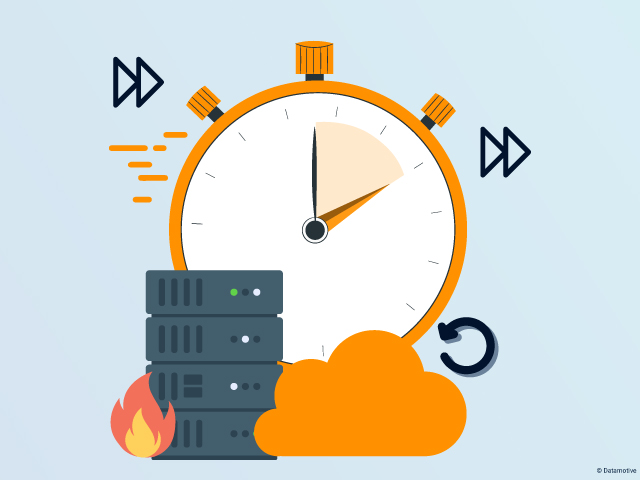Disasters, both natural and human-caused, pose a constant threat to businesses of all sizes. From severe weather events and cyberattacks to equipment failures and human error, disruptions can strike unexpectedly, bringing operations to a halt and jeopardizing critical data. In today's interconnected and data-driven world, downtime translates to lost revenue, reputational damage, and potentially even business closure. A robust disaster recovery (DR) plan is no longer a luxury but a fundamental requirement for business continuity and resilience. As a CIO, you bear the crucial responsibility of ensuring your organization can weather these storms and recover swiftly. This post delves into practical strategies for achieving faster disaster recovery times, minimizing the risk of data loss, and ultimately safeguarding your business's future.
Why Data Loss is Unacceptable?
The term “data-driven” is what explains today’s world; data is the most crucial element any organization. Losing data can lead to:
- Financial Losses: Lost sales, regulatory fines, and recovery costs can significantly impact the bottom line.
- Reputational Damage: Customer trust erodes quickly after a data breach or prolonged outage.
- Operational Disruption: Inability to access critical systems can cripple business operations.
- Legal and Compliance Issues: Data loss can lead to non-compliance with industry regulations.
Therefore, your DR plan must prioritize both speed and data integrity.
Key Strategies for Faster Recovery and Zero Data Loss
Minimizing downtime and preventing data loss are the twin pillars of effective disaster recovery. Achieving these goals requires a multi-faceted approach, encompassing careful planning, strategic technology adoption, and ongoing testing. The following strategies outline key steps CIOs can take to accelerate recovery times, safeguard critical data, and ensure business continuity in the face of unforeseen disruptions.
1. Implement a Robust Backup and Replication Strategy
- 3-2-1 Rule: Follow the 3-2-1 backup rule: Keep at least three copies of your data, on two different media types, with one copy offsite.
- Continuous Data Protection (CDP): CDP captures every data change as it happens, enabling near-instantaneous recovery and minimizing data loss.
- Regular Backups: Schedule regular backups of critical systems and data, including databases, applications, and virtual machines.
- Replication: Replicate data to a secondary location, either on-premises or in the cloud, for rapid failover.
2. Go For Cloud-Based Disaster Recovery
Cloud computing offers several advantages for DR:
- Cost-Effectiveness: Avoid the high capital expenditure of building and maintaining a secondary data center.
- Scalability and Flexibility: Easily scale resources up or down as needed.
- Faster Recovery Times: Cloud providers offer robust infrastructure and tools for rapid failover.
- Geographic Redundancy: Store data in geographically diverse locations to protect against regional disasters.
3. Virtualization and Infrastructure as Code (IaC)
- Virtualization: Virtualize your infrastructure to simplify DR testing and failover. Virtual machines can be easily replicated and restored.
- IaC: Use IaC to automate the provisioning and configuration of your DR environment. This ensures consistency and speeds up recovery.
4. Automated Failover and Failback
- Automated Failover: Implement automated failover mechanisms to switch to the secondary location in case of a disaster. This minimizes downtime and human error.
- Automated Failback: After the primary site is restored, automate the failback process to return operations to the primary location.
5. Regular DR Testing and Drills
- Regular Testing: Test your DR plan regularly to identify weaknesses and ensure it works as expected.
- Disaster Recovery Drills: Conduct simulated disaster scenarios to train your IT team and refine your DR procedures. These drills should be as realistic as possible.
6. Prioritize Critical Systems and Data
- Identify Critical Systems: Determine the most critical systems and data that need to be recovered first.
- Recovery Time Objective (RTO): Define the maximum acceptable downtime for each critical system.
- Recovery Point Objective (RPO): Define the maximum acceptable data loss for each critical system.
7. Security Considerations
- Secure Backups: Encrypt your backups to protect against unauthorized access.
- Access Control: Implement strict access control measures to limit access to sensitive data.
- Security Audits: Regularly audit your DR environment to identify and address security vulnerabilities.
Faster Disaster Recovery Without Data Loss With Datamotive
Datamotive's EasyHybridDR is a disaster recovery solution that helps businesses recover from data crashes in 10 minutes. EasyHybridDR is the only disaster recovery solution that can replicate and recover all compliance and regulatory controls.
In addition to these benefits, EasyHybridDR also offers a number of other features that can help businesses recover from data crashes more quickly and easily. These features include:
- A simple and intuitive user interface that makes it easy to set up and manage disaster recovery plans.
- A wide range of features that can be customized to meet the specific needs of your business.
- A team of experienced support engineers who are available to help you with any questions or problems you may have.
Conclusion
Achieving faster disaster recovery without data loss requires a proactive and comprehensive approach. By implementing the strategies outlined in this blog post, CIOs can significantly improve their organization's resilience and ensure business continuity in the face of any disaster. A well-defined and tested DR plan is an investment in your organization's future. Don't wait for a disaster to strike – start planning today.
